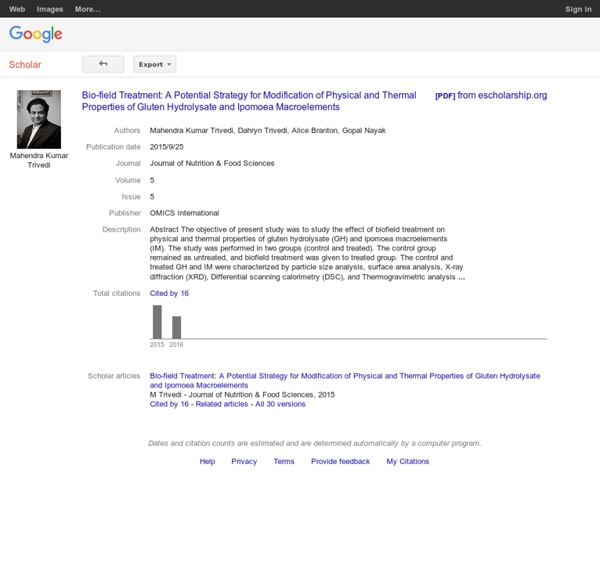



Physical Properties of Gluten Hydrolysate <div class="c-box-warning full-width-element" style="text-align: center; "><div style="margin: auto; padding:10px;" class="container"><b>For full functionality of ResearchGate it is necessary to enable JavaScript. Here are the <a href=" rel="nofollow" target="_blank"> instructions how to enable JavaScript in your web browser</a>.</b></div></div>
Bio-field Treatment: A Potential Strategy for Modification of Physical and Thermal Properties of Gluten Hydrolysate and Ipomoea Macroelements Share this: Embed* Cite this: Trivedi, Mahendra Kumar (2015): Bio-field Treatment: A Potential Strategy for Modification of Physical and Thermal Properties of Gluten Hydrolysate and Ipomoea Macroelements. figshare. Evaluation of Phenotyping and Genotyping Characteristic of Shigella sonnei after Biofield Treatment Abstract Shigella sonnei (S. sonnei) is a non-motile, rod shape, clinically significant, Gram-negative bacterium. It is commonly associated with dysentery (shigellosis).
Evaluation of Biofield Treatment Dose and Distance in a Model of Cancer Cell Death conducted in parallel that indicated a relatively stable baseline variability in the data output from the modelsystem. However, the interpretation of these results iscomplicated by the lack of replicability observed in thesecond set of experiments using the same model systemand the same participants. Part of the struggle is rec-onciling the centuries of precedent in which the test of replicability has been a fundamental tenet of the scien-tific method, and the acknowledgment that the experi-mental intervention in this model system derives from ahuman being and may thus be inherently changing withtime and situation (e.g., mental and emotional state at aparticular time).
Spectroscopic Characterization of Biofield Treated Metronidazole and Tinidazole Title: Spectroscopic Characterization of Biofield Treated Metronidazole and Tinidazole Select license: Creative Commons Attributions-NonCommercial-ShareAlike Updated: November 19th, 2016
FT-IR Analysis of Biofield Treated Tetracycline Description Objective: Chloramphenicol and tetracycline are broad-spectrum antibiotics and widely used against variety of microbial infections. Nowadays, several microbes have acquired resistance to chloramphenicol and tetracycline. The present study was aimed to evaluate the impact of biofield treatment for spectroscopic characterization of chloramphenicol and tetracycline using FT-IR and UV-Vis spectroscopy. Methods: The study was performed in two groups (control and treatment) of each antibiotic.
Publication meta - Spectroscopic Characterization of Disulfiram and Nicotinic Acid after Biofield Treatment - Publications - MyScienceWork Disulfiram is being used clinically as an aid in chronic alcoholism, while nicotinic acid is one of a B-complex vitamin that has cholesterol lowering activity. The aim of present study was to investigate the impact of biofield treatment on spectral properties of disulfiram and nicotinic acid. The study was performed in two groups i.e., control and treatment of each drug. The treatment groups were received Mr. Publication meta - Evaluation of Biofield Treatment Dose and Distance in a Model of Cancer Cell Death - Publications Objective: This study assessed the potential influence of biofield treatment on cultured human cancer cells and whether such influence was affected by varying the duration of the treatment (dose) or the distance between the biofield practitioner and the target cells. Design: Biofield treatment dosage was assessed from a short distance (0.25 meters) in three independent experiments involving 1, 2, or 5 treatments, along with another set of three independent and comparable mock experiments. Biofield treatment distance was assessed at 0.25, 25, and * 2000 meters involving two treatments in three independent experiments along with another set of three mock experiments. Intervention: Biofield treatments were delivered by a highly acclaimed biofield practitioner with the intention of diminishing growth of the cells or inducing cancer-cell death. Outcome measure: Cell viability was quantified 20 hours after treatments, using a spectrophotometric assay for live-cell counting.
Evaluation of Biofield Treatment Dose and Distance in a Model of Cancer Cell Death *The embed functionality can only be used for non commercial purposes. In order to maintain its sustainability, all mass use of content by commercial or not for profit companies must be done in agreement with figshare. Description Objective: This study assessed the potential influence of biofield treatment on cultured human cancer cells and whether such influence was affected by varying the duration of the treatment (dose) or the distance between the biofield practitioner and the target cells.Design: Biofield treatment dosage was assessed from a short distance (0.25 meters) in three independent experiments involving 1, 2, or 5 treatments, along with another set of three independent and comparable mockexperiments. Comments (0)
Thermal and Physical Properties of Biofield Treated Bile Salt and Proteose Peptone 0WordPress0CiteULike0 4 Bile salt (BS) and proteose peptone (PP) are important biomacromolecules being produced inside the human body. The objective of this study was to investigate the influence of biofield treatment on physicochemical properties of BS and PP. The study was performed in two groups (control and treated). The control group remained as untreated, and biofield treatment was given to treated group.